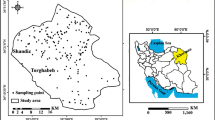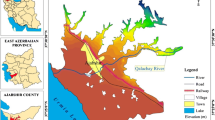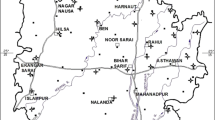Abstract
Contamination from agriculture diffuse particularly nitrate is an important concern due to its impact on groundwater quality and human health. To ensure the protection of groundwater and effectively improve the quality of life, an overlay index-based method is proposed by taking into consideration of all pollution sources that causes potential risk to the resource in this study. A comparison had been presented between the original DRASTIC and DRASTIC-L (land use) to identify the suitability of model for probability of pollution occurrence which help in optimizing the drilling activities and safeguarding the resources. The outcome of the result is categorized into five vulnerability classes which shows that 25.9% of the total study area is extremely sensitive due to overdraft of groundwater and contamination from agriculture and industrial diffuse. The effectiveness of model was validated with correlation (r2) among water quality parameters and DRASTIC index (DI). Moreover, to exhibit better finding in terms of the specific vulnerability to agriculture contamination (NO3−) in the aquifers, DRASTIC-L was adopted in which above 50% samples exceeded WHO water quality permissible limit. The efficiency of both methods was quantitatively assessed based on the correlation of nitrate, which was improved from r2 of 0.40–0.57. The finding suggests that though the depth of water is relatively shallow as compared to central Gujarat, future overexploitation at vulnerable zones should be carefully monitored.







Similar content being viewed by others
Data availability
Data will be made available on request.
References
Alam F, Umar R, Ahmed S, Dar FA (2014) A new model (DRASTIC-LU) for evaluating groundwater vulnerability in parts of central Ganga Plain, India. Arab J Geosci 7(3):927–937. https://doi.org/10.1007/s12517-012-0796-y
Aller L, Bennett T, Lehr JH, Petty RJ, Hackett G (1987) DRASTIC : a Standardized method for evaluating ground water pollution potential using hydrogeologic settings. NWWA/Epa-600/2-87-035 455
Anderson JR (1976) A land use and land cover classification system for use with remote sensor data (Vol. 964). US Government Printing Office
Arya S, Subramani T, Vennila G, Roy PD (2020) Groundwater vulnerability to pollution in the semi-arid Vattamalaikarai river basin of South India thorough DRASTIC index evaluation. Geochemistry 80(4):125635
Bera A, Mukhopadhyay BP, Chowdhury P, Ghosh A, Biswas S (2021) Groundwater vulnerability assessment using GIS-based DRASTIC model in Nangasai River Basin, India with special emphasis on agricultural contamination. Ecotoxicol Environ Saf 214:112085. https://doi.org/10.1016/j.ecoenv.2021.112085
Bordbar M, Neshat A, Javadi S, Pradhan B, Aghamohammadi H (2020) Meta-heuristic algorithms in optimizing GALDIT framework: A comparative study for coastal aquifer vulnerability assessment. J Hydrol 585:124768. https://doi.org/10.1016/j.jhydrol.2020.124768
Boulabeiz M, Klebingat S, Agaguenia S (2019) A GIS-based GOD model and hazard index analysis: the quaternary Coastal Collo Aquifer (NE-Algeria). Groundwater 57:166–176. https://doi.org/10.1111/gwat.12824
Buczko U, Kuchenbuch RO (2010) Environmental indicators to assess the risk of diffuse nitrogen losses from agriculture. Environ Manage 45(5):1201–1222
Central Groundwater Board, Ground Water Brochure and Profile of Sabarkantha District. Nayak, K.M. 2014
Dassargues RCGA (2000) art%3A10.1007%2Fs002540050466.pdf 39.
Elzain HE, Chung SY, Venkatramanan S, Selvam S, Ahemd HA, Seo YK, Bhuyan MS, Yassin MA (2022) Novel machine learning algorithms to predict the groundwater vulnerability index to nitrate pollution at two levels of modeling. Chemosphere 137671
Ghiglieri G, Barbieri G, Vernier A, Carletti A, Demurtas N, Pinna R, Pittalis D (2009) Potential risks of nitrate pollution in aquifers from agricultural practices in the Nurra region, northwestern Sardinia, Italy. J Hydrol 379(3–4):339–350
Ghosh A, Tiwari AK, Das S (2015) A GIS based DRASTIC model for assessing groundwater vulnerability of Katri Watershed, Dhanbad, India. Model Earth Syst Environ 1:1–14. https://doi.org/10.1007/s40808-015-0009-2
Goyal D, Haritash AK, Singh SK (2021) A comprehensive review of groundwater vulnerability assessment using index-based, modelling and coupling methods. J Environ Manage 296:113161. https://doi.org/10.1016/j.jenvman.2021.113161
Haidu I, Nistor MM (2020) Groundwater vulnerability assessment in the Grand Est region, France. Quat Int 547:86–100
Hasan M, Islam MA, Hasan MA, Alam MJ, Peas MH (2019) Groundwater vulnerability assessment in Savar upazila of Dhaka district, Bangladesh—a GIS-based DRASTIC modeling. Groundw Sustain Dev 9:100220
Heiß L, Bouchaou L, Tadoumant S, Reichert B (2020) Index-based groundwater vulnerability and water quality assessment in the arid region of Tata city (Morocco). Groundw Sustain Dev 10:100344
Hussain Y, Ullah SF, Hussain MB, Aslam AQ, Akhter G, Martinez-Carvajal H, Cárdenas-Soto M (2017) Modelling the vulnerability of groundwater to contamination in an unconfined alluvial aquifer in Pakistan. Environ Earth Sci. https://doi.org/10.1007/s12665-017-6391-5
Jahromi MN, Gomeh Z, Busico G, Barzegar R, Samany NN, Aalami MT, Tedesco D, Mastrocicco M, Kazakis N (2021) Developing a SINTACS-based method to map groundwater multi-pollutant vulnerability using evolutionary algorithms. Environ Sci Pollut Res 28:7854–7869. https://doi.org/10.1007/s11356-020-11089-0
Jenifer MA, Jha MK (2018) Comprehensive risk assessment of groundwater contamination in a weathered hard-rock aquifer system of India. J Clean Prod 201:853–868. https://doi.org/10.1016/j.jclepro.2018.08.005
Jia Z, Bian J, Wang Y, Wan H, Sun X, Li Q (2019) Assessment and validation of groundwater vulnerability to nitrate in porous aquifers based on a DRASTIC method modified by projection pursuit dynamic clustering model. J Contam Hydrol 226:103522. https://doi.org/10.1016/j.jconhyd.2019.103522
Kazakis N, Voudouris KS (2015) Groundwater vulnerability and pollution risk assessment of porous aquifers to nitrate: Modifying the DRASTIC method using quantitative parameters. J Hydrol 525:13–25. https://doi.org/10.1016/j.jhydrol.2015.03.035
Khosravi K, Sartaj M, Tsai FTC, Singh VP, Kazakis N, Melesse AM, Prakash I, Tien Bui D, Pham BT (2018) A comparison study of DRASTIC methods with various objective methods for groundwater vulnerability assessment. Sci Total Environ 642:1032–1049. https://doi.org/10.1016/j.scitotenv.2018.06.130
Kundu MC, Mandal B (2009) Nitrate enrichment in groundwater from long-term intensive agriculture: its mechanistic pathways and prediction through modeling. Environ Sci Technol 43(15):5837–5843
Machiwal D, Jha MK, Singh VP, Mohan C (2018) Assessment and mapping of groundwater vulnerability to pollution: current status and challenges. Earth-Science Rev 185:901–927. https://doi.org/10.1016/j.earscirev.2018.08.009
McLay CDA, Dragten R, Sparling G, Selvarajah N (2001) Predicting groundwater nitrate concentrations in a region of mixed agricultural land use: a comparison of three approaches. Environ Pollut 115(2):191–204
Muhammetoǧlu H, Muhammetoǧlu A, Soyupak S (2002) Vulnerability of groundwater to pollution from agricultural diffuse sources: a case study. Water Sci Technol 45:1–7. https://doi.org/10.2166/wst.2002.0191
Nadiri AA, Norouzi H, Khatibi R, Gharekhani M (2019) Groundwater DRASTIC vulnerability mapping by unsupervised and supervised techniques using a modelling strategy in two levels. J Hydrol 574:744–759. https://doi.org/10.1016/j.jhydrol.2019.04.039
Nanou EA, Zagana E (2018) Groundwater vulnerability to pollution map for karst aquifer protection (Ziria karst system, Southern Greece). Geosciences 8:15–18. https://doi.org/10.3390/geosciences8040125
National Research Council (NRC) (1993) Groundwater vulnerability assessment: predictive relative contamination potential under conditions of uncertainty. National Academy Press, Washington, DC, p 211p
Nekkoub A, Baali F, Hadji R, Hamed Y (2020) The EPIK multi-attribute method for intrinsic vulnerability assessment of karstic aquifer under semi-arid climatic conditions, case of Cheria Plateau, NE Algeria. Arab J Geosci. https://doi.org/10.1007/s12517-020-05704-0
Neshat A, Pradhan B, Dadras M (2014) Groundwater vulnerability assessment using an improved DRASTIC method in GIS. Resour Conserv Recycl 86:74–86. https://doi.org/10.1016/j.resconrec.2014.02.008
Patel DP, Srivastava P, Gupta M, Nandhakumar N (2015) Decision Support System integrated with Geographic Information System to target restoration actions in watersheds of arid environment: a case study of Hathmati watershed, Sabarkantha district, Gujarat. J Earth Syst Sci 124(1):71–86
Pathak DR, Hiratsuka A, Awata I, Chen L (2009) Groundwater vulnerability assessment in shallow aquifer of Kathmandu Valley using GIS-based DRASTIC model. Environ Geol 57:1569–1578. https://doi.org/10.1007/s00254-008-1432-8
Ray JA, O’dell PW (1993) DIVERSITY: a new method for evaluating sensitivity of groundwater to contamination. Environ Geol 22:345–352. https://doi.org/10.1007/BF00767508
Rebolledo B, Gil A, Flotats X, Sánchez JÁ (2016) Assessment of groundwater vulnerability to nitrates from agricultural sources using a GIS-compatible logic multicriteria model. J Environ Manage 171:70–80. https://doi.org/10.1016/j.jenvman.2016.01.041
Rina K, Datta PS, Singh CK, Mukherjee S (2013) Characterization and evaluation of processes governing the groundwater quality in parts of the Sabarmati basin, Gujarat using hydrochemistry integrated with GIS. Hydrol Process 26(10):1538–1551
Saha D, Alam F (2014) Groundwater vulnerability assessment using DRASTIC and Pesticide DRASTIC models in intense agriculture area of the Gangetic plains, India. Environ Monit Assess 186(12):8741–8763
Sharma A, Shukla A, Attri K, Kumar M, Kumar P, Suttee A, Singh G, Barnwal RP, Singla N (2020) Global trends in pesticides: a looming threat and viable alternatives. Ecotoxicol Environ Saf. https://doi.org/10.1016/j.ecoenv.2020.110812
Sheikh MA, Azad C, Mukherjee S, Rina K (2017) An assessment of groundwater salinization in Haryana state in India using hydrochemical tools in association with GIS. Environ Earth Sci 76:465
Shirazi SM, Imran HM, Akib S, Yusop Z, Harun ZB (2013) Groundwater vulnerability assessment in the Melaka State of Malaysia using DRASTIC and GIS techniques. Environ Earth Sci 70:2293–2304. https://doi.org/10.1007/s12665-013-2360-9
Shrestha S, Semkuyu DJ, Pandey VP (2016) Assessment of groundwater vulnerability and risk to pollution in Kathmandu Valley, Nepal. Sci Total Environ 556:23–35. https://doi.org/10.1016/j.scitotenv.2016.03.021
Sinha MK, Verma MK, Ahmad I, Baier K, Jha R, Azzam R (2016) Assessment of groundwater vulnerability using modified DRASTIC model in Kharun Basin, Chhattisgarh, India. Arab J Geosci 9(2):1–22
State Agriculture Plan (2017–2020) http://rkvy.nic.in/static/SAIDP/GJ/For%20this%20Period(2017-18%20to%202019-20)/SAP_SAIDP_GUJARAT.pdf
Suthar S, Bishnoi P, Singh S, Mutiyar PK, NemaPatil AKNS (2009) Nitrate contamination in groundwater of some rural areas of Rajasthan, India. J Hazardous Mater 171(1–3):189–199
Tanushree KR (2021) A hydrochemical and remote sensing approach to decrypt the groundwater salinization in the coastal district of Sabarmati basin, Gujarat. Groundw Sustain Dev 15:100673
Thapa R, Gupta S, Guin S, Kaur H (2018) Sensitivity analysis and mapping the potential groundwater vulnerability zones in Birbhum district, India: a comparative approach between vulnerability models. Water Sci 32(1):44–66
Vias J, Andreo B, Ravbar N, Hotzl H (2010) Mapping the vulnerability of groundwater to the contamination of four carbonate aquifers in Europe. J Environ Manag 91(7):1500–1510
Voutchkova DD, Schullehner J, Rasmussen P, Hansen B (2021) A high-resolution nitrate vulnerability assessment of sandy aquifers (DRASTIC-N). J Environ Manage 277:111330
Wei A, Bi P, Guo J, Lu S, Li D (2021) Modified DRASTIC model for groundwater vulnerability to nitrate contamination in the Dagujia river basin, China. Water Supply 21(4):1793–1805
WHO (World Health Organization) (2014) Guidelines for Drinking Water Quality Recommendations, fourth ed., vol. 1, pp. 491–493
Acknowledgements
The present research is a part of ECR/2015/000202 project sanctioned by Science and Engineering Research Board. The authors are grateful to the authorities of Groundwater Resource Development Corporation for providing data and permission to publish the present work and SERB for providing research grant for the study.
Author information
Authors and Affiliations
Contributions
T: data interpretation and analysis, and manuscript drafting. RK: conceptualization, supervision, and manuscript editing.
Corresponding author
Ethics declarations
Competing interests
There is no competing interest between the authors.
Additional information
Publisher's Note
Springer Nature remains neutral with regard to jurisdictional claims in published maps and institutional affiliations.
Rights and permissions
Springer Nature or its licensor (e.g. a society or other partner) holds exclusive rights to this article under a publishing agreement with the author(s) or other rightsholder(s); author self-archiving of the accepted manuscript version of this article is solely governed by the terms of such publishing agreement and applicable law.
About this article
Cite this article
Gupta, T., Kumari, R. Assessment of groundwater nitrate vulnerability using DRASTIC and modified DRASTIC in upper catchment of Sabarmati basin. Environ Earth Sci 82, 216 (2023). https://doi.org/10.1007/s12665-023-10880-9
Received:
Accepted:
Published:
DOI: https://doi.org/10.1007/s12665-023-10880-9




